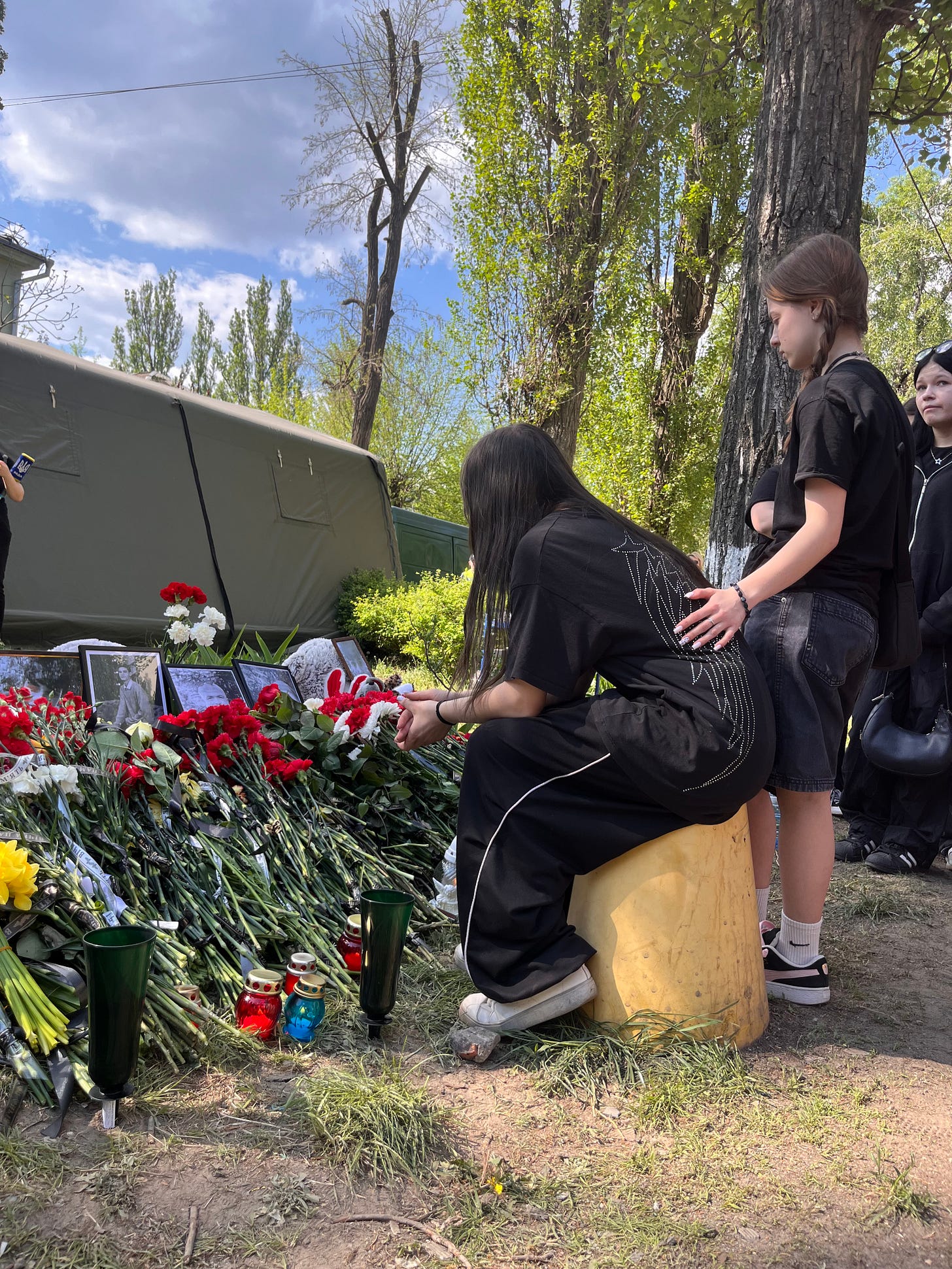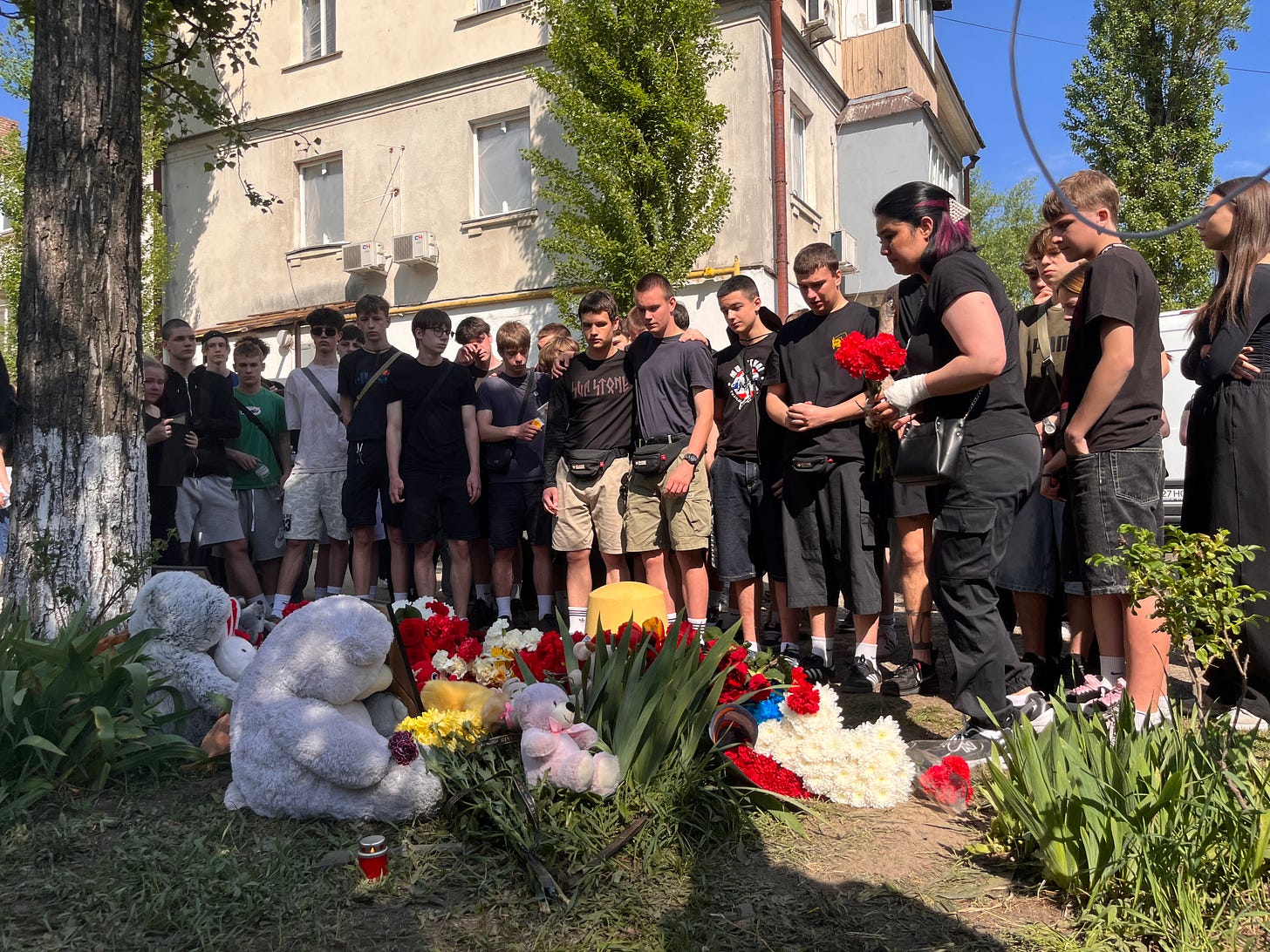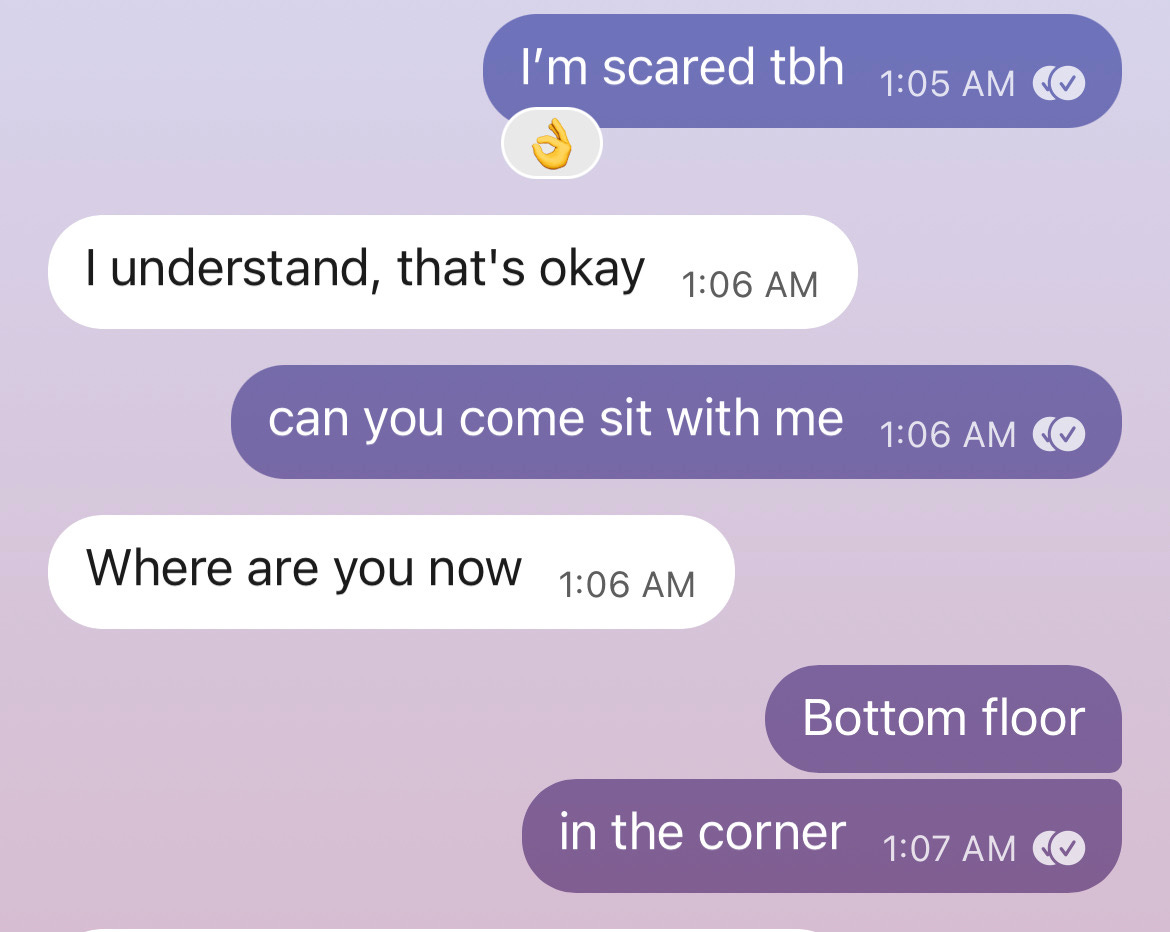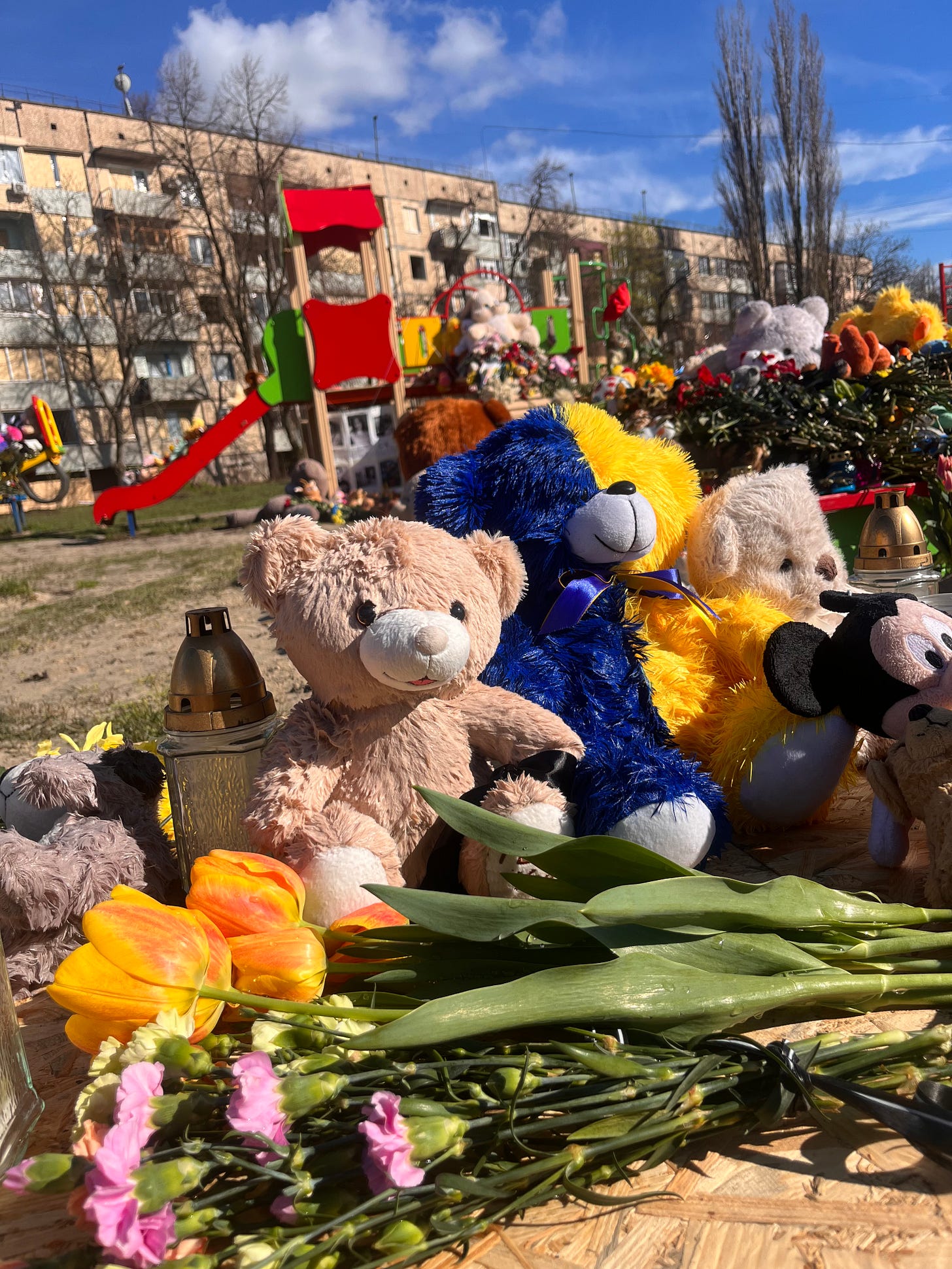
It was almost 1 a.m. when the attack started. The drones came first, followed by the oddly soothing rat-tat-tat of anti-aircraft guns firing from nearby rooftops and then, just as I moved into my hallway to get away from the windows, the first of the larger explosions. As I sped downstairs, away from a roof which suddenly felt thin as gauze, I checked my Telegram feed to see what the attack monitoring channels were saying about incoming threats.
A message leered on the screen:
Kyiv, nablyzhennya balistyky! Kyiv, approaching ballistics!
A few seconds later, a massive blast shook the sky.
Kyiv, nablyzhennya balistyky!
Another blast.
Kyiv, nablyzhennya balistyky!
I huddled in a corner and tapped out a text to my friend, who was still upstairs in my apartment.
When he came downstairs, he discovered that the gate to the building’s basement was open, so he ferried me down into the dark. Then he went back up, and returned with a bottle of vodka, a carton of pomegranate juice, and two plastic cups.
The basement was pitch-black and damp and smelled of rodents. It was empty, save for a tangle of hot water pipes and a low bench which someone had doubtless placed there early in the full-scale invasion, when Kyiv residents went to the basements far more often, not being as accustomed to things blowing up as they are now.
We sat on the bench sipping makeshift cocktails as I shivered, even though it was very hot. My friend was stoic. I used to be just as calm for most of my two-and-a-half years here. Late last year that started to change, though I don’t quite know why. Nerves fray over time, I guess.
“I’m sorry,” I said to my friend, who was, to be honest, a little bit bored. “I don’t know what’s gotten into me lately.”
Kyiv, nablyzhennya balistyky!
The water pipes hissed so loudly, we couldn’t hear if there were any more explosions.
— — —
The morning after that intense barrage of ballistic missiles and cruise missiles and attack drones struck Kyiv, we went for a long walk after just a few hours of sleep. A faint smell of smoke found my nose, drifting from the fires that had burned through the night where the missiles struck; about seven kilometres away, a residential block lay in ruins. Otherwise, it was a perfect spring day, clear blue skies and birdsong and a gentle floral-scented breeze.
At the playground next to my apartment, a gaggle of children were clambering over the play structures, squealing, arguing the rules of impromptu games, giggling with unrestrained glee. It was a bit surreal, knowing they’d just passed the same long and awful night I did, woken by massive violence, huddling in a basement or a bathtub or perhaps just in their beds, with their parents holding them tight. It sinks inside them, I know, even if, in their exuberant play, they don’t show it the morning after.
The sight of the playground itself struck a bitter chord in my gut. A few weeks prior, I had gone on a work trip to Kryvyi Rih, where Russia had struck a playground in a very quiet residential neighbourhood with a ballistic missile armed with a cluster munition warhead — an anti-personnel weapon, designed to destroy what military jargon refers to as “soft targets.”
In Kryvyi Rih, the soft targets in question were 20 civilians, nine of them children. At the strike site, the head of the city’s military administration told me, vehemently, that there were no military sites or critical infrastructure within five kilometres of the site; one may typically take this with a grain of salt, but after driving around the area, I was inclined to trust that statement. All I saw were playgrounds, shops, and unremarkable Soviet-era apartment blocks.
Immediately after the strike, Russia had said it targeted a meeting of military officers in a small floral cafe beside the playground; security video showed there was no such meeting. The cafe had, in fact, hosted a beauty industry convention that day. The only people left when the missile hit were staff, and a few young women cleaning up from the beauty event. A war crime, as clear as any other. Nine kids dead.
At a hospital in Dnipro, I met two of the only survivors from the playground, a woman and her three-year-old daughter. The story ran on the cover of the Globe and Mail, but what the story could not quite capture was how difficult it was to handle my emotions as I sat in the hospital room, looking at three-year-old Afina as she coloured. Her face and arms and legs were peppered with black shrapnel wounds. She will live, but she’ll have bits of a Russian missile inside her body forever.
It’s one thing to read about these things. It’s another to see them in the flesh. As her mother and I spoke through the translator, I covered my mouth with my hand to hide how my lips twisted, until I could swallow my anger.
— — —
I’ve been really struggling to write lately. A lot has happened, and I have about seven or eight half-written newsletters saved in my drafts, but I just couldn’t find the heart to finish them, and then the time to write about those subjects passed.
Last fall, I was out marking a friend’s birthday and chatting with an acquaintance, an American woman who has been living a long time in Ukraine. We were talking about how I’m going back to Canada this summer, and I was working through my thoughts on that, which are bittersweet and complicated and tinged with some dread about all that I’ll have to leave behind.
Yet I do have to come home, for many financial and personal reasons. And there was one other reason someone had suggested to me, which is that the world feels as if it’s entering a very uncertain and dangerous phase of history. Given that, I said, maybe it is wisest to go home; Canada is as safe a place as any.
“I’d rather be somewhere important than safe,” my acquaintance replied.
This comment stung, and later that night, I spent some time thinking about why. I arrived at a conclusion in two parts. The first is this: everywhere is important to the people that live there. Everywhere has people who suffer. I’m from the child poverty capital of Canada, where we’re still finding Indigenous women in dumpsters. There’s no shortage of important things at home to which I can direct my attention.
Which leads me to a second understanding, that in part explains why I’ve found it so hard to write. I think a lot of us in journalism got here and stayed here because it was a way to feel useful: by being a conduit to share our stories with each other, by shining lights on the places that hurt, sometimes we get to help ease that hurting — and more, that effect is magnified the closer we are to the community we’re covering.
I’ve felt this effect many times. In the midst of a heat wave in 2021, I wrote about how a local mutual aid group on Facebook was trying to find portable air conditioners and fans to get to vulnerable people living in sweltering-hot apartments.
The response from Winnipeggers was astounding. I knew our readers would help, yet I still underestimated just how much. The morning that story came out, I was deluged with calls from folks wanting to contribute. One man called me from Canadian Tire to say he’d just bought out their entire stock of one floor fan model, and wanted to know where to drop them off. With that story, we facilitated an immediate, potentially even life-saving improvement to the lives of dozens of elders and vulnerable families.
Even when the impact isn’t so direct and material, I can still see the ripple effects all around me at home. I’ve advocated for the values I hold dear and I believe I’ve played my part in conversations that have carried us further down the path of reconciliation, as one example. Seeing things change is quite motivating.
The truth is, in Ukraine, I feel terribly helpless. I can put a story about an atrocity on the cover of The Globe and Mail, but it doesn’t change anything. Playgrounds keep on being bombed and my friends keep being killed and people I love keep on watching as their home cities are stolen by Russia and razed to rubble. The machinery of war, both logistical and geopolitical, is so vast, we’re all just specks.
I want to find the story that stops the war. I want to find the story that makes all the playgrounds here safe. But I can’t; none of us can. In a way we have to accept we’re a little bit helpless to change the big picture, though there’s a fine line between coming to terms with that, and hopelessness.
I don’t want to give in to the latter, and don’t think I have yet. But it does sap some of the inspiration, when you’re so keenly aware that it’ll just be another story, without a chance of sparking some immediate change — when you know that the morning after, the bombs will still fall the same.
— — —

Thirteen people were killed in that April 24 attack on Kyiv. At least one of the missiles slammed into a densely-packed residential neighbourhood, collapsing roofs and floors onto human bodies. Among the dead were several teens; my friend Samya Kullab from Associated Press wrote the most beautiful piece about one of their stories.
On Friday afternoon, about 38 hours after the strike, friends and classmates of some of the victims arrived at the memorial near the rubble. They came all together, about 30 kids in black t-shirts and solemn faces, shuffling past police tape and firemen and psychologists from Ukraine’s state emergency service, who wandered the site in case anyone needed help.
They came, and they laid red flowers and small bags of candy on the memorial pile, in front of portraits of the dead. Then for long minutes they stood there in silence, arms wrapped around each other, the boys’ jaws clenching as they fought back tears.
TV cameras rolled.
Photographers crouched to take pictures.
The kids knew the journalists were there, both foreign and local. They knew their moment of grief would not be private. Still, they came together and stood together, facing the cameras. It was a silent statement, louder than words; they wanted their grief to be seen. They wanted the world to see how they were united — knowing it was testament to the life of their friend.
They’re braver than they should ever have to be, I thought. And far more beautiful than this nightmare deserves.
I’m usually not one to be in front of the camera, but recently it’s found me: I’m in two new documentaries that are being released soon, and the trailers for both are online.
First: about a year ago, my longtime friend Jeremy Regan — the owner of Winnipeg’s Hunter & Gunn barbershop — came to Kyiv with a film crew, and we met a few times to film and interview and just hang out and reminisce about our misspent youth. I’ve known Jeremy for nearly 25 years, so it was surreal to connect with him here.
The result of his project is a very cool documentary, The Wandering Barber. Think of it like Anthony Bourdain’s shows, where he travelled the world telling stories through food, but with cutting hair. There’s a split-second shot of me in the trailer and a much longer scene in the full doc, which will premiere on Canada’s SuperChannel in June.
Second: in late 2022, when I was first contacted to appear in a documentary about my former Red River College journalism instructor — and later convicted bank robber — Steve Vogelsang, I both was and wasn’t surprised. Was, because it’s always a little bit surprising when highly Winnipeg stories catch fire internationally; wasn’t, because if any true crime story had the mix of curiosity and outsized characters that makes for a titillating retelling, it was this one.
I filmed my interview just days before I came to Ukraine in January 2023. My feelings on the whole shebang are a bit complicated; I agreed to be in it only because someone else did, and I’ll leave it at that. I honestly have no idea how it will land, but the trailer promises that, if nothing else, it’s going to be a wild ride.
Stories like this are inevitably a bit more about the audience grappling with how well they know a person, I think — or coming to terms with disconnect between how they perceived someone they admired, and the reality. I get a sense this documentary will be exploring that in a creative way, for those who didn’t know or know of Steve.
It’s out this week on Amazon Prime.
Until next time, friends.
-mm




